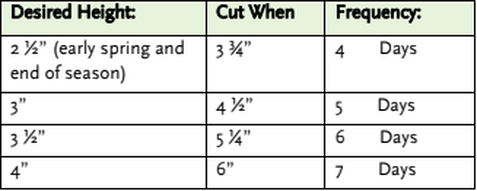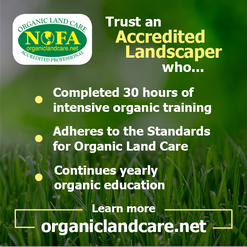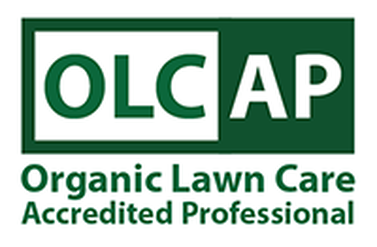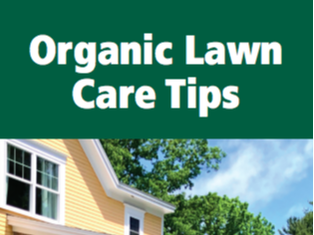FIND A PROFESSIONAL
PESTS
If you find yourself faced with a pest problem that must be managed it is important to avoid use of products that can harm beneficial organisms in our landscapes. The vast majority of insects in your yard are helpful. They provide valuable ecosystem services like pollination, pest control, soil aeration, nutrient recycling and more. Organic IPM is a least toxic way of managing pests. There are five main steps.
First, identify the pest.
Second, learn about the pest’s biology.
Third, determine the level you are able to tolerate.
Fourth, modify your habitat to deter the pest.
Fifth, monitor pest abundance and damage, if any.
Often times after following these steps, control measures are not needed. Some least toxic controls include exclusion, traps, handpicking, vacuuming, water sprays, and judicious pruning. If a pest still remains above tolerance levels after implementing these options, then an organic compatible product may be considered. This would include OMRI certified and minimum risk (25(b) exempt) products. Follow all label directions exactly to avoid harming beneficial and non-target organisms. See Organic Alternatives for product suggestions.
Source: Introduction to Organic Lawns and Yards by Sarah Little, PhD
First, identify the pest.
Second, learn about the pest’s biology.
Third, determine the level you are able to tolerate.
Fourth, modify your habitat to deter the pest.
Fifth, monitor pest abundance and damage, if any.
Often times after following these steps, control measures are not needed. Some least toxic controls include exclusion, traps, handpicking, vacuuming, water sprays, and judicious pruning. If a pest still remains above tolerance levels after implementing these options, then an organic compatible product may be considered. This would include OMRI certified and minimum risk (25(b) exempt) products. Follow all label directions exactly to avoid harming beneficial and non-target organisms. See Organic Alternatives for product suggestions.
Source: Introduction to Organic Lawns and Yards by Sarah Little, PhD
LAWNS
10 Steps to Healthy Organic Turf
1. Annual Soil Test
SEND SOIL SAMPLE TO SOIL TESTING FACILITY. A soil test provides necessary information to establish a realistic turf management program. Test for pH, buffer pH, Organic Matter, Cation Exchange Capacity (CEC) and calcium:magnesium ratio.
2. Organic Fertilizer
APPLY AN ALL NATURAL ORGANIC FERTILIZER EVERY 7-10 WEEKS. Organic fertilizers feed the soil biology and the soil biology feeds the plant. Buy products that contain water insoluble nitrogen and low or no phosphorous.
3. Soil Chemistry
APPLY SOIL AMENDMENTS ACCORDING TO SOIL TEST RESULTS. Maintain pH 6.5-7.0 using calcitic or dolomitic lime based on calcium to magnesium ratio. Rate & frequency determined by buffer pH. To adjust calcium only use gypsum.
4. Soil Structure
APPLY SOIL AMENDMENTS ACCORDING TO SOIL TEST RESULTS. Improve Organic Matter & CEC using humates, biochar & compost, products. Calcium helps break up clay soils. Top dress with loam/compost to create 6" soil depth.
5. Mow Right
MOST IMPORTANT CULTURAL PRACTICE!!! Mow High - 3-1/2 inches to encourage deep roots and shade the soil. Cut no more than 1/3 of the grass blade at a time. Avoid mowing wet grass. Sharpen mower blades after every 8 hours to prevent tearing grass blade. Damaged grass blades lose moisture and are susceptible to disease.
6. Return Grass Clippings
ADDS ORGANIC MATTER AND IS A NATURAL FERTILIZER (additional 1lb “N” in a season). Bag clippings when weed seeds and flowers are present (ie. crabgrass, dandelions) to mitigate further spread of seeds.
7. Water
DEEP, INFREQUENTLY AND IN THE MORNING. 3/4 - 1 inch of water a week (1-2X week). Newly seeded areas and during extreme heat water more frequently for shorter periods. Over watering leads to compaction and disease.
8. Core Aerate
RELIEVE SOIL COMPACTION. Aerate when grass is actively growing to allow grass roots to spread and improve air circulation in the root zone. Fall is the best time.
9. Over-seed
CREATE A DENSE STAND OF GRASS TO CROWD OUT WEEDS. In SPRING seed slice thin lawns. Top dress and over seed trouble spots. Broadcast grass seed when aerating in the Fall. Water to establish.
10. Scout for Weeds & Pests
WEEDS ARE AN INDICATION OF UNDERLYING SOIL CONDITIONS. Work at creating the environment grass requires to grow (steps 1-9) and in 3-5 years weeds diminish. In the mean-time, manually pull weeds and re-seed bare areas, treat grubs with hB nematodes or cedar product. Over watering & improper mowing contribute to weed pressure.
Source: PJC Organic PDF version
SEND SOIL SAMPLE TO SOIL TESTING FACILITY. A soil test provides necessary information to establish a realistic turf management program. Test for pH, buffer pH, Organic Matter, Cation Exchange Capacity (CEC) and calcium:magnesium ratio.
2. Organic Fertilizer
APPLY AN ALL NATURAL ORGANIC FERTILIZER EVERY 7-10 WEEKS. Organic fertilizers feed the soil biology and the soil biology feeds the plant. Buy products that contain water insoluble nitrogen and low or no phosphorous.
3. Soil Chemistry
APPLY SOIL AMENDMENTS ACCORDING TO SOIL TEST RESULTS. Maintain pH 6.5-7.0 using calcitic or dolomitic lime based on calcium to magnesium ratio. Rate & frequency determined by buffer pH. To adjust calcium only use gypsum.
4. Soil Structure
APPLY SOIL AMENDMENTS ACCORDING TO SOIL TEST RESULTS. Improve Organic Matter & CEC using humates, biochar & compost, products. Calcium helps break up clay soils. Top dress with loam/compost to create 6" soil depth.
5. Mow Right
MOST IMPORTANT CULTURAL PRACTICE!!! Mow High - 3-1/2 inches to encourage deep roots and shade the soil. Cut no more than 1/3 of the grass blade at a time. Avoid mowing wet grass. Sharpen mower blades after every 8 hours to prevent tearing grass blade. Damaged grass blades lose moisture and are susceptible to disease.
6. Return Grass Clippings
ADDS ORGANIC MATTER AND IS A NATURAL FERTILIZER (additional 1lb “N” in a season). Bag clippings when weed seeds and flowers are present (ie. crabgrass, dandelions) to mitigate further spread of seeds.
7. Water
DEEP, INFREQUENTLY AND IN THE MORNING. 3/4 - 1 inch of water a week (1-2X week). Newly seeded areas and during extreme heat water more frequently for shorter periods. Over watering leads to compaction and disease.
8. Core Aerate
RELIEVE SOIL COMPACTION. Aerate when grass is actively growing to allow grass roots to spread and improve air circulation in the root zone. Fall is the best time.
9. Over-seed
CREATE A DENSE STAND OF GRASS TO CROWD OUT WEEDS. In SPRING seed slice thin lawns. Top dress and over seed trouble spots. Broadcast grass seed when aerating in the Fall. Water to establish.
10. Scout for Weeds & Pests
WEEDS ARE AN INDICATION OF UNDERLYING SOIL CONDITIONS. Work at creating the environment grass requires to grow (steps 1-9) and in 3-5 years weeds diminish. In the mean-time, manually pull weeds and re-seed bare areas, treat grubs with hB nematodes or cedar product. Over watering & improper mowing contribute to weed pressure.
Source: PJC Organic PDF version
Organic Turf Care Cultural Practices

Organic Products + Cultural Practices = Healthy Lawn
Mowing
In an All Natural Organic Turf Care (OTC) program proper mowing heights can and do have a significant impact on the likely success of the program. Higher mowing heights contribute to shading the soil which directly affects soil temperature and blocking sunlight to the soil surface. Both of these, cooler soil temperature and lack of sunlight discourage weed seed germination. With more surface area the turf grass is able to carry on greater levels of photosynthesis. Through increased levels of photosynthesis a deeper, more vigorous root system is developed. Greater root mass enables the turf grass to be more wear resistant, drought tolerant, and endure greater stress. Another benefit of a healthy root system is the addition of as much as 1⁄2 to 4 tons of organic matter per acre to the soil on an annual basis. Mowing heights should change over the course of the growing season starting at 2 1⁄2 ” in early spring – moving to
3”to 4” by June and ending the season in November at 2 1⁄2 ”.
When mowing, cut no more than 1/3 of the grass blade at a time.
Grass should ideally be maintained between 3 1⁄2 - 4”. The following
guide will help determine when your grass should be cut & how often.
Grass Clippings
In an All Natural Turf Care program grass clippings should be returned. With a healthy ecosystem the
return of clippings adds to the soil organic matter and serves as a natural fertilizer equal to one application
per season. The healthy soil biology will breakdown the grass clippings.
Watering
Watering should be deep, infrequent and in the morning. Established grass should receive 3⁄4” – 1” of water a week through natural rain fall or irrigation. If irrigating this may mean that each zone is in operation for 50 minutes to an hour depending on flow rate. To test how much water is being delivered, use a small can and measure the water collected. During extreme heat the grass should be watered more frequently for shorter periods. Over watering can lead to soil compaction and disease.
Watering – Over-seeded areas: Water 2X a day for approximately 10 - 15 minutes, mid morning & afternoon, to ensure soil and seed stay moist – not wet. Maintain watering schedule until seed germinates, approximately two - three weeks. Once the seed germinates, cut back watering to once per day in the morning, then every other day, then twice per week as the root system gets establishes. Once germination is complete you need to water 1 inch weekly to maintain a healthy lawn. Grass can take up to 18 months to become fully established.
Turf Density
A dense lawn is the best way to crowd out weeds. Grass like any crop must be regularly planted to ensure the highest yield (thickest lawn). Since grass is cut before it goes to seed it is necessary to periodically over-seed. In the spring we recommend seed slicing to avoid bringing weed seeds to the surface. Late summer/early fall is the best time to repair thin lawns by broadcast over seeding when aerating.
Source: PJC Organic PDF version
Mowing
In an All Natural Organic Turf Care (OTC) program proper mowing heights can and do have a significant impact on the likely success of the program. Higher mowing heights contribute to shading the soil which directly affects soil temperature and blocking sunlight to the soil surface. Both of these, cooler soil temperature and lack of sunlight discourage weed seed germination. With more surface area the turf grass is able to carry on greater levels of photosynthesis. Through increased levels of photosynthesis a deeper, more vigorous root system is developed. Greater root mass enables the turf grass to be more wear resistant, drought tolerant, and endure greater stress. Another benefit of a healthy root system is the addition of as much as 1⁄2 to 4 tons of organic matter per acre to the soil on an annual basis. Mowing heights should change over the course of the growing season starting at 2 1⁄2 ” in early spring – moving to
3”to 4” by June and ending the season in November at 2 1⁄2 ”.
When mowing, cut no more than 1/3 of the grass blade at a time.
Grass should ideally be maintained between 3 1⁄2 - 4”. The following
guide will help determine when your grass should be cut & how often.
Grass Clippings
In an All Natural Turf Care program grass clippings should be returned. With a healthy ecosystem the
return of clippings adds to the soil organic matter and serves as a natural fertilizer equal to one application
per season. The healthy soil biology will breakdown the grass clippings.
Watering
Watering should be deep, infrequent and in the morning. Established grass should receive 3⁄4” – 1” of water a week through natural rain fall or irrigation. If irrigating this may mean that each zone is in operation for 50 minutes to an hour depending on flow rate. To test how much water is being delivered, use a small can and measure the water collected. During extreme heat the grass should be watered more frequently for shorter periods. Over watering can lead to soil compaction and disease.
Watering – Over-seeded areas: Water 2X a day for approximately 10 - 15 minutes, mid morning & afternoon, to ensure soil and seed stay moist – not wet. Maintain watering schedule until seed germinates, approximately two - three weeks. Once the seed germinates, cut back watering to once per day in the morning, then every other day, then twice per week as the root system gets establishes. Once germination is complete you need to water 1 inch weekly to maintain a healthy lawn. Grass can take up to 18 months to become fully established.
Turf Density
A dense lawn is the best way to crowd out weeds. Grass like any crop must be regularly planted to ensure the highest yield (thickest lawn). Since grass is cut before it goes to seed it is necessary to periodically over-seed. In the spring we recommend seed slicing to avoid bringing weed seeds to the surface. Late summer/early fall is the best time to repair thin lawns by broadcast over seeding when aerating.
Source: PJC Organic PDF version
WEED CONTROL
Urban landscapes require vegetation management in flower beds and hardscaped areas like patios and walkways. There are many organic compatible alternatives to choose from. What you choose depends on at least two things - what you need to remove, and where you need to do it.
Non chemical methods include:
- hand pulling
- boiling water
- smothering with cardboard/plastic etc.
- mulching
- weed whacking
- Fiskars weeder
- Pullerbear
- Buckthorn Baggies
- goats
Least toxic chemical options include:
- kitchen or horticultural vinegar (wear proper protective equipment when using horticultural strength vinegar)
- various OMRI listed products
- various FIFRA 25 (b) exempt products
For invasive species, the same applies: What you choose depends on at least two things - what you need to remove, and where you need to do it.
Options for invasive removal include:
- hand removal - be thorough and persistent, have a five year plan
- weed wrench tools
- girdling invasive trees - where safe to do so it leaves behind a snag, which is beneficial to wildlife
- conservation grazing - goats, sheep, chickens
- smother cropping - a thick, rapidly growing crop that is used to suppress or stop the growth of unwanted plants
- prescribed flooding
- controlled burning
- biological controls
- organic herbicides - can be used with an injection tool
Product examples can be found here. Use good judgement when choosing products, look for the least toxic option for the job, and always follow label directions exactly.
PLANTS
Our yards are more than just a place to live and relax. They provide us with the opportunity to establish practices that can reverse urgent environmental issues like climate change, habitat loss, and insect declines.
Aside from eliminating synthetic fertilizers and pesticides - one of the most straightforward things we can do to support biodiversity is by planting native trees, shrubs, and flowers. The non-native ornamental plants in most suburban yards do not provide vital food for wildlife. But by planting native, you can help support adult pollinators and other wildlife with nectar and habitat, and provide food for insect larval stages. Insects like butterflies and moths need these host plants to be able to breed and increase their numbers. The caterpillars the plants host are food for baby birds. Did you know it takes 6000 to 9000 caterpillars to raise one clutch of chickadees? Be sure to provide a variety of flowers and bloom times. The greater the diversity of native plants, the more biodiversity they can support.
Avoid cultivars of natives (aka nativars) and opt for the straight or wild species. In many if not most cases, a plant that has been changed to appeal to humans no longer provides the same benefits to wildlife. For example, if you want to purchase coneflowers, look for Echinacea purpurea, not Echinacea purpurea “Cheyenne Spirit.” The name at the end indicates the plant is not a wild species. Be sure plants you purchase have not been treated with any systemic pesticides like neonicotinoids or fungicides.
Find native plants suitable for your region
Look for your state's native plant society
GARDEN EQUIPMENT
The choices we make in how we maintain our yards matters, and that includes the tools we use. Gas lawn and garden equipment are an often overlooked and substantial contributor to air pollution and greenhouse gas emissions.
The engines in lawnmowers and leaf blowers pollute our air with harmful particulate matter and VOCs, as well as stirring up dust, pollen, mold, and other respiratory irritants. Just one hour of gas lawnmower use is equal to driving 300 miles in a passenger vehicle. One hour of gas leaf blower use is equal to driving 1100 miles. The California Air Resources Board reports that pollution from gas-powered gardening equipment will exceed that from all the passenger cars in the state by the year 2020.
The noise from gas equipment is harmful to our health and hearing, wildlife and disrupts the peace and quiet in our neighborhoods.
Better alternatives exist so that we can still have well-maintained landscapes without the pollution and excessive noise of gas equipment.
We also have the option of adapting our landscapes to need less maintenance. Shrink the lawn area, create a mini meadow with native wildflowers and leave leaves to decompose and nourish flower beds naturally. What other ways can you think of to make your yard more sustainable?
The engines in lawnmowers and leaf blowers pollute our air with harmful particulate matter and VOCs, as well as stirring up dust, pollen, mold, and other respiratory irritants. Just one hour of gas lawnmower use is equal to driving 300 miles in a passenger vehicle. One hour of gas leaf blower use is equal to driving 1100 miles. The California Air Resources Board reports that pollution from gas-powered gardening equipment will exceed that from all the passenger cars in the state by the year 2020.
The noise from gas equipment is harmful to our health and hearing, wildlife and disrupts the peace and quiet in our neighborhoods.
Better alternatives exist so that we can still have well-maintained landscapes without the pollution and excessive noise of gas equipment.
- Electric equipment is available for every task around the yard, including mowers, trimmers and even chainsaws.
- Hand tools like rakes and brooms never go out of style and give you a great workout.
- People powered machines like reel mowers, work for small yards. Leaf sweepers and push sweepers are a good way to make cleanup easier.
We also have the option of adapting our landscapes to need less maintenance. Shrink the lawn area, create a mini meadow with native wildflowers and leave leaves to decompose and nourish flower beds naturally. What other ways can you think of to make your yard more sustainable?





